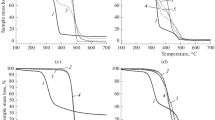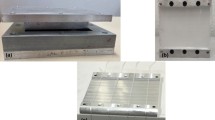Abstract
Strength-deformation characteristics of low-density polyethylene filled with microcrystalline cellulose “Thermocell” as a function of the TC content (up to 0.7 parts by weight) are studied. Characteristics such as elastic modulus, relative elongation at break, ultimate strength, and work of failure are determined. Water sorption and change in the size and strength-deformation characteristics of composite specimens during exposure to boiling water (560 min) are also studied. It is shown that with greater filler content it is possible to increase the strength-deformation characteristics of LDPE, such as elastic modulus and tensile strength. The growth of the ultimate strength is associated with the formation of a specific filler framework with increasing filler content. It is found that the main factors which cause a decrease in the elastic modulus and softening of the composite are failure of the filler framework as well as formation of stresses and voids during water sorption by the composite. It is demonstrated that the steady reproducibility of the composition, attainable high filling degrees, and ecological safety make Thermocell a promising filler for polyethylene.
Similar content being viewed by others
References
V. M. Shapovalov, V. G. Barsukov, E. N. Lapshina, and V. I. Gubkin, “Composite facing materials from wood fibers and thermoplastics,” Stroit. Mater., No. 5, 18–20 (1991).
V. I. Gubkin, Z. G. Kovalyova, and S. F. Melnikov, “Filling of recycled thermoplastics by wastes of veneer grinding,” Plast. Massy, No. 2, 47–48 (1991).
E. P. Mamunya, V. D. Mishak, E. V. Lebedev, and V. F. Annenkov, “Features of formation of wood-polymeric materials,” Plast. Massy, No. 8, 39–41 (1989).
M. G. Laka and S. A. Chernyavskaya, “Physicomechanical properties of composites containing ‘Thermocell’ microcrystalline cellulose as filler,” Mech. Compos. Mater.,32, No. 4, 381–386 (1996).
Yu. S. Lipatov, Physical Chemistry of Filled Polymers [in Russian], Khimiya, Moscow (1977).
R. G. Raj, B. V. Kokta, and C. Daneault, “Wood flour as a low-cost reinforcing filler for polyethylene: studies on mechanical properties,” J. Mater. Sci.,25, 1851–1855 (1990).
R. T. Woodhams, G. Thomas, and D. K. Rodgers, “Wood fibers as reinforcing fillers for polyolefins,” Polym. Eng. Sci.,24, 1166–1171 (1984).
R. Simpson and S. Selke, “Composite materials from recycled multi-layer polypropylene bottles and wood fibers,” Polym. Prepr. Amer. Chem. Soc. Div. Chem.,2, 148–149 (1991).
R. G. Raj, B. V. Kokta, and C. A. Daneault, “Comparative study on the effect of aging on mechanical properties of LLDPE-glass fiber, mica and wood fiber composites,” J. Appl. Polym. Sci.,40, 645–655 (1990).
J. M. Felix and P. Gatenholm, “The nature of adhesion in composites of modified cellulose fibers and polypropylene,” J. Appl. Polym. Sci.,42, 609–620 (1991).
R. G. Raj and B. V. Kokta, “Composites of silane treated cellulosic fibers and high density polyethylene,” Die Angewandte Makromolekulare Chemie,189, No. 189, 169–182 (1991).
V. A. Belyi, B. I. Kupchinov, V. G. Barsukov, and V. M. Shapovalov, “Processing by extrusion of composite materials on the basis of chopped wood and thermoplastics,” Plast. Massy, No. 11, 42–44 (1987).
C. Klason, J. Kubat and H. E. Strömvall, “The efficiency of cellulosic fillers in common thermoplastics. Pt. 1: Filling without processing aids or coupling agents,” Int. J. Polym. Mater.,10, 159–187 (1984).
M. I. Garbara, M. S. Akutina, and N. M. Egorova (eds.), Handbook of Plastics [in Russian], Khimiya Moscow (1967).
Author information
Authors and Affiliations
Additional information
Translated from Mekhanika Kompozitnykh Materialov, Vol. 35, No. 1, pp. 79–90, January–February, 1999.
Rights and permissions
About this article
Cite this article
Maskavs, M., Kalnins, M., Reihmane, S. et al. Effect of water sorption on some mechanical parameters of composite systems based on low-density polyethylene and microcrystalline cellulose. Mech Compos Mater 35, 55–62 (1999). https://doi.org/10.1007/BF02260812
Received:
Revised:
Issue Date:
DOI: https://doi.org/10.1007/BF02260812




